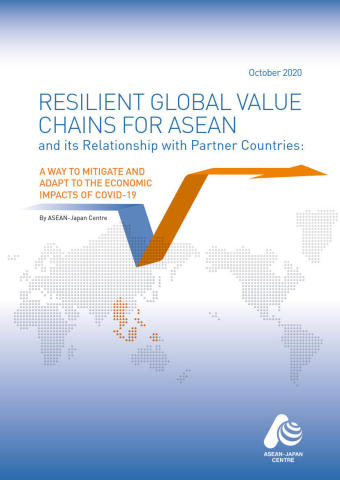
The report "Resilient Global Value Chains for ASEAN and its Relationship with Partner Countries" is available for download on AJC website. (Graphic: Business Wire)
TOKYO, Oct 16 (Bernama-BUSINESS WIRE) -- In the publication, entitled Resilient Global Value Chains (GVCs) for ASEAN and its Relationship with Partner Countries published by the ASEAN-Japan Centre (AJC) today, AJC proposed that each country and each company in ASEAN engaged in international production networks should examine its vulnerability of value chains to external risks in the respective industry with possible reference to the AJC’s risk calculation.
This press release features multimedia. View the full release here: https://www.businesswire.com/news/home/20201015006128/en/
There has been a series of calls at the international and regional levels for strengthening and rebuilding value chains since the outbreak of COVID-19. Although this is a natural consequence of efficient procurement, when their supply or distribution chains are concentrated in a few firms and a few countries, companies have always a legitimate concern as to whether they will continue to receive required materials and inputs from suppliers. Then, the question is where and at what stage the value chain is concentrated.
In response to this question, AJC calculated the degree of risks of value chains to external shocks and identified which industries tend to be more vulnerable to risks. Two types of risks — risks that affect the upstream part of GVCs (supplier market concentration) and those that affect the downstream part of GVCs (buyer market concentration) — are considered.
Looking at concentration by partner in the supplier market, China is by far the most important supplier to many industries in ASEAN. China occupies a market share that enhances its market power enough to cause a competitive concern in more than half of ASEAN Member States’ standardized 222 industries (129). Japan occupies 38 industries. With regards to the buyer market concentration, China does not figure as the main buyer in many industries (only 11 industries where its market concentration is influential). Japan occupies 24 industries.
Further, AJC proposed a set of five strategies to build resilient GVCs in ASEAN. They include:
In response to this question, AJC calculated the degree of risks of value chains to external shocks and identified which industries tend to be more vulnerable to risks. Two types of risks — risks that affect the upstream part of GVCs (supplier market concentration) and those that affect the downstream part of GVCs (buyer market concentration) — are considered.
Looking at concentration by partner in the supplier market, China is by far the most important supplier to many industries in ASEAN. China occupies a market share that enhances its market power enough to cause a competitive concern in more than half of ASEAN Member States’ standardized 222 industries (129). Japan occupies 38 industries. With regards to the buyer market concentration, China does not figure as the main buyer in many industries (only 11 industries where its market concentration is influential). Japan occupies 24 industries.
Further, AJC proposed a set of five strategies to build resilient GVCs in ASEAN. They include:
- Utilization of pandemic-related policy measures and actions implemented by ASEAN Member States
- Improvement in risk management by the private sector
- Strong push for digital transformation by both public and private sectors
- Promoting new and crisis-resistant industries
- Reconsidering company strategies for international production: offshoring or reshoring
For effectively dealing with the COVID-19 crisis and its economic aftermath, it is important for policymakers to resist the temptation of quick-fix solutions or protectionism and to maintain an overall favorable business climate.
The publication is available for download on AJC website: https://www.asean.or.jp/en/centre-wide/resilient_gvcs/
View source version on businesswire.com:
https://www.businesswire.com/news/home/20201015006128/en/
Contact
Tomoko Miyauchi
Office of Secretary General, PR
ASEAN-Japan Centre
URL: https://www.asean.or.jp/en/
E-mail: toiawase_ga@asean.or.jp
Source : ASEAN-Japan Centre
The publication is available for download on AJC website: https://www.asean.or.jp/en/centre-wide/resilient_gvcs/
View source version on businesswire.com:
https://www.businesswire.com/news/home/20201015006128/en/
Contact
Tomoko Miyauchi
Office of Secretary General, PR
ASEAN-Japan Centre
URL: https://www.asean.or.jp/en/
E-mail: toiawase_ga@asean.or.jp
Source : ASEAN-Japan Centre
No comments:
Post a Comment